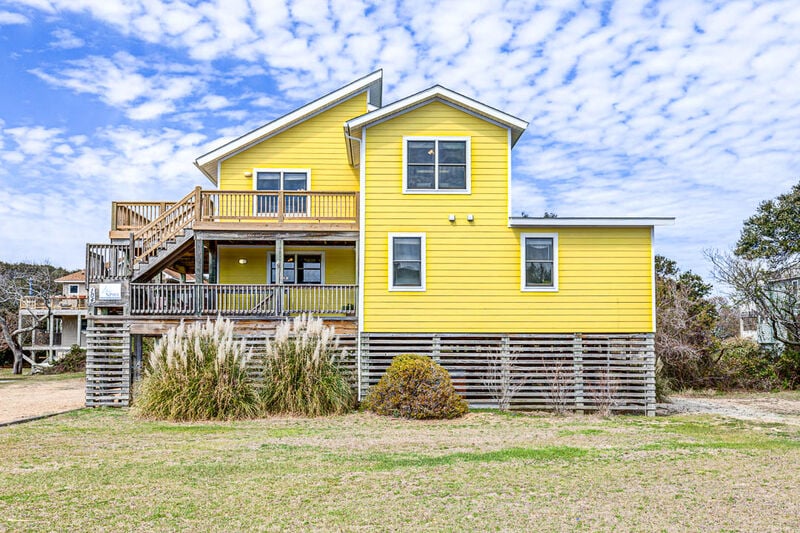
"The Graveyard of the Atlantic." That's what Southern seafarersused to call the North Carolina Outer Banks. Before the advent of electronicnavigation, countless ships ran aground during furious storms, crashed intohidden shoals, or sank in the Gulf Stream's fierce, turbulent current.
To prevent such shipwrecks, four towering lighthouses were erected alongthe Outer Banks - the Cape Lookout Lighthouse, completed in 1812 and rebuilt in1859; the Ocracoke Lighthouse, constructed in 1823; the Bodie IslandLighthouse, initially built in 1847 and rebuilt twice afterward; and the famousCape Hatteras Lighthouse, completed in 1870.
But one stretch of OBX coastline still remained unprotected - the 40-milenorthern section between Cape Henry and Bodie Island. Here, in this treacherous"dark space," vessels continued to wreck, with loss of both life andcargo.
A Light in the Darkness
Finally, in 1872, the U.S. Light-House Board approved construction of a massivebrick light station at Corolla, in the heart of the "dark space." By late1875 the Currituck Beach Lighthouse was completed. And on December 1 of thatyear, the lighthouse's first-order Fresnel lens began flashing its guiding light18 nautical miles out across the Atlantic.
Today this legendary lighthouse still stands at its original site nearthe historic Whalehead Club. It still has its rotating Fresnel lens, nowcompletely automated. And it still sends out its familiar signal nightly fromdusk to dawn, flashing for three seconds out of every 20.
Best of all, you can visit this beautiful beacon and climb its spiralstaircase to the observation deck at the top, where you'll enjoy a thrilling360-degree view of Currituck Sound, the Atlantic Ocean, Currituck Beach, andmore.
What's Special About the Currituck Beach Lighthouse? (Hint: It's Red!)
If you're familiar with other Outer Banks lighthouses, you know abouttheir distinctive designs - those iconic white brick walls painted with bold blackstripes.
But the Currituck lighthouse has no painted pattern at all. It wasdeliberately left unpainted so seafarers could tell it apart from the other OBXlight stations.
Today, when you visit this unique lighthouse, you'll find the originalstructure intact: a majestic red brick tower, 162 feet tall, built with a million bricks. In late afternoon, thesetting sun gives this impressive structure a warm red-golden glow.
Nearby you'll find the Lighthouse Keepers' House, a clapboard Victorianstructure completed in 1876. Two families shared this duplex, one on eitherside. A third house - for another keeper's family - was moved to the site in1920.
Today these historic structures are in the process of being restored.While the original duplex still needs some interior work, the smaller 1920house has been completely renovated. Now transformed into a gift shop, it'sopen daily during the season, selling lighthouse replicas, T-shirts, books,art, souvenirs, and more.
What to Expect When You Climb the Tower (220 Steps in All)
The lighthouse's rugged iron stairwell may be steep and winding, but it'ssurprisingly easy to climb. Most people reach the top in about five or sixminutes, but you can take as long as you like. Plus, you can pause and catchyour breath on the staircase's ninelandings.
You'll pay $10 per person to climb (plus sign a liability waiver). Kids 7and under climb free, but they must be accompanied by an adult.
Before you begin your ascent, check out the ground-level Archives Room.Here you'll find period photos, handwritten letters, and other historicartifacts offering a fascinating glimpse into the lives of the early lightkeepers. You'll learn about their trials and hardships, their family relationships,and even their feuds. (One keeper actually accused his colleague of poisoninghis dog!)
As you climb, be sure to linger at each of the first three landings,where museum-quality exhibits highlight the light station's colorful history. Plus,look for special window displays indicating your exact position - the directionyou're facing and your altitude above sea level.
When you reach the top (158 feet above sea level), you'll view abreathtaking vista that literally stretches for miles. You'll feel theexhilarating sea breeze and taste the tang of the salty air.
And when you look upward, you'll see the original Fresnel lens, stillused to guide local mariners. As a "first-order lens," it's thelargest-size Fresnel lantern available. Inthe beginning, it was fueled by lard oil. Later this was changed to mineraloil. By 1939, it had switched over to electric-powered automation.
That meant light keepers were no longer needed to operate the intricatemechanism for rotating and flashing the beacon. The keepers left, and an eraended.
As you gaze around the lantern room, take a moment to drink it all in. You'llget a powerful sense of the romance and mystique of this chapter in Outer Bankshistory.The CurrituckLighthouse is open daily from 9 a.m. to 5 p.m. from mid-March through December1. On Wednesdays and Thursdays from Memorial Day through Labor Day, thelighthouse and grounds stay open till 8 p.m.









